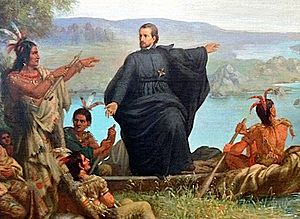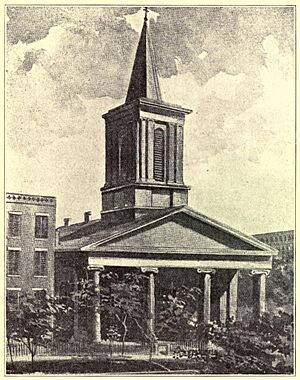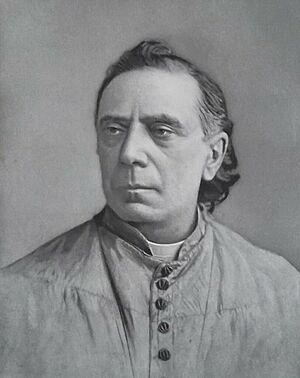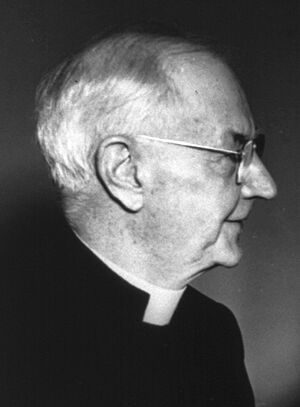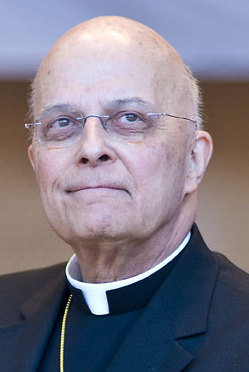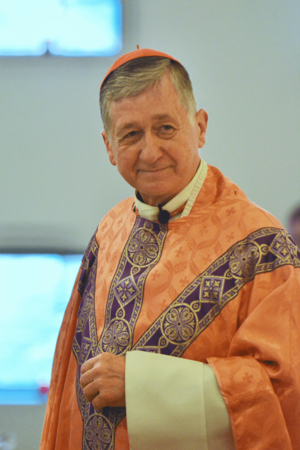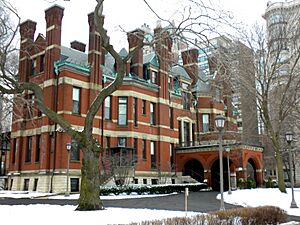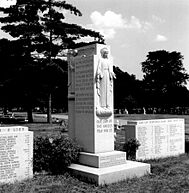Roman Catholic Archdiocese of Chicago facts for kids
Quick facts for kids Archdiocese of ChicagoArchidiœcesis Chicagiensis |
|
|---|---|
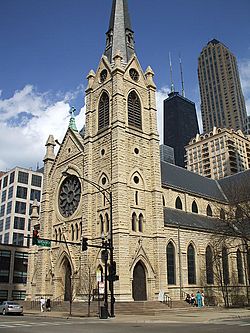
Holy Name Cathedral
|
|
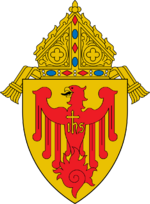
Coat of arms
|
|
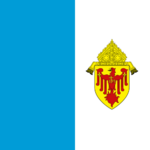
Flag
|
|
| Location | |
| Country | United States |
| Territory | Counties of Cook and Lake |
| Ecclesiastical province | Chicago |
| Statistics | |
| Area | 1,411 sq mi (3,650 km2) |
| Population - Total - Catholics |
(as of 2017) 5.94 million 2,079,000 (35%) |
| Parishes | 216 (As of 1/2024) |
| Schools | 154 archdiocesan-run 34 non-archdiocesan-run |
| Information | |
| Denomination | Catholic Church |
| Sui iuris church | Latin Church |
| Rite | Roman Rite |
| Established | November 28, 1843 |
| Cathedral | Holy Name Cathedral |
| Patron saint | Immaculate Conception |
| Secular priests | 672 |
| Current leadership | |
| Pope | Francis |
| Archbishop | Blase Joseph Cupich |
| Auxiliary Bishops |
|
| Emeritus Bishops |
|
| Map | |
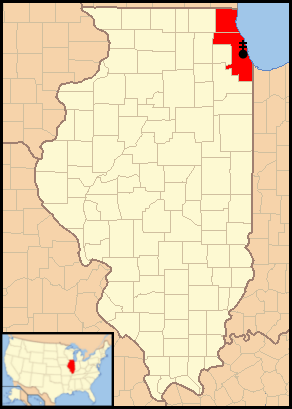 |
|
The Archdiocese of Chicago is a large and important area for the Catholic Church in the United States. It is located in northeastern Illinois. An archdiocese is a large territory led by an archbishop. The Vatican first created it as a smaller area called a diocese in 1843. It became an archdiocese in 1880.
The current leader is Cardinal Blase J. Cupich. The main church, called a cathedral, is the beautiful Holy Name Cathedral. It is located in the Near North Side neighborhood of Chicago.
The archdiocese serves over 2 million Catholics in Cook and Lake counties. This is a big area covering 1,411 square miles. It is the main archdiocese for all other Catholic dioceses in Illinois, including Belleville, Joliet, Peoria, Rockford, and Springfield.
One of its most well-known leaders was Cardinal Joseph Bernardin. He was the archbishop from 1982 to 1996. He was famous for bringing people of different faiths together.
Contents
History of the Archdiocese
The story of the Catholic Church in Chicago goes back hundreds of years.
Early Days: 1600s to 1840s
In the 1600s, Illinois was part of New France, a French colony. The first Catholic to arrive was a French Jesuit missionary named Reverend Jacques Marquette. He landed near the Chicago River in 1674 and built a small cabin. This was the first European settlement in the area. Soon, more French missionaries and settlers came.
After the American Revolution, the area became part of the United States. In 1833, there were about 100 Catholics in Chicago. They asked for a priest, so Reverend John Saint Cyr came to lead them. He built the first Catholic church in the city, St. Mary's, for only $400.
Becoming a Diocese: 1843 to 1880
By 1843, the Catholic community had grown so much that Pope Gregory XVI made Chicago its own diocese. He named Reverend William Quarter from Ireland as the first bishop. Bishop Quarter was very organized. He helped pass a law that allowed the church to own land. This meant he could build more churches and schools.
He invited a group of nuns called the Sisters of Mercy to Chicago in 1846. They started schools and orphanages. Bishop Quarter also opened the first university in Chicago, St. Mary of the Lake University, in 1846.
In 1871, the Great Chicago Fire destroyed many buildings, including St. Mary's Cathedral. A new one, the Cathedral of the Holy Name, was built in 1875. It is still the main cathedral today.
A Growing Archdiocese: 1880 to 1930
In 1880, the church in Chicago became an archdiocese, and Bishop Patrick Feehan became the first archbishop. During this time, many immigrants came to Chicago from countries like Poland, Italy, and Lithuania. The Catholic population grew to 800,000 people.
Archbishop Feehan started 140 new parishes. Many of these were "national parishes" for specific ethnic groups. These churches helped immigrants feel at home with familiar languages and traditions. He also supported Catholic education and helped start what is now DePaul University.
In 1926, Chicago hosted a huge event called the 28th International Eucharistic Congress. It brought Catholics from all over the world to the city.
Mid-Century Changes: 1930 to 1980
Cardinal George Mundelein became archbishop in 1915. He organized the many parish schools into a single system. This meant all schools had the same books, training for teachers, and rules.
In 1958, a terrible fire at Our Lady of the Angels School killed 92 students and three nuns. This tragedy led to big changes in fire safety rules for schools across the country.
During the 1960s, Archbishop Albert Gregory Meyer spoke out against racial discrimination. He wanted to make sure the church was a welcoming place for everyone.
Modern Times: 1980 to Today
In 1982, Archbishop Joseph Bernardin became the leader. He was known for being a good listener and brought a feeling of unity to the archdiocese. He also started the Council of Religious Leaders of Metropolitan Chicago to work with people of other faiths.
Cardinal Francis George became archbishop in 1997. He was the first leader of the archdiocese to have been born in Chicago. In 2011, he made a difficult decision to end the Catholic Charities foster care program. This happened after a disagreement with the state over new rules.
In 2014, Pope Francis appointed Bishop Blase J. Cupich as the new archbishop. He has worked on reorganizing the archdiocese to meet modern needs. This has included combining some parishes and schools to make them stronger.
A historic event occurred on May 8, 2025, when Robert Francis Prevost, who grew up in Chicago and attended schools run by the archdiocese, became the first U.S. Pope. He took the name Pope Leo XIV.
Important Churches and Buildings
For a long time, people in Chicago identified themselves by the church they attended. Knowing someone's parish told you a lot about their background and neighborhood.
The archbishop's residence is a beautiful, three-story brick building built in 1885. It is listed on the National Register of Historic Places. Archbishops lived there until 2014. When Pope John Paul II visited Chicago in 1979, he stayed at this residence. Today, it is used as a guesthouse.
Leadership of the Archdiocese
The Archdiocese of Chicago has been led by many bishops and archbishops. Since 1915, the leader of the archdiocese has also been named a cardinal, which is a high-ranking advisor to the Pope.
Bishops of Chicago
- William J. Quarter (1844–1848)
- James Oliver Van de Velde (1848–1853)
- Anthony O'Regan (1854–1858)
- James Duggan (1859–1880)
Archbishops of Chicago
- Patrick Augustine Feehan (1880–1902)
- James Edward Quigley (1903–1915)
- Cardinal George Mundelein (1915–1939)
- Cardinal Samuel Stritch (1939–1958)
- Cardinal Albert Gregory Meyer (1958–1965)
- Cardinal John Cody (1965–1982)
- Cardinal Joseph Bernardin (1982–1996)
- Cardinal Francis George (1997–2014)
- Cardinal Blase J. Cupich (2014–present)
Catholic Schools
The Office of Catholic Schools runs one of the largest private school systems in the United States. The first Catholic school in Chicago was a school for boys that opened in 1844.
Over the years, many schools were started by religious sisters to serve immigrant communities. These schools taught students from German, Polish, Italian, Mexican, and many other backgrounds.
As of 2022, the archdiocese had 33 high schools and many elementary schools. These schools educate tens of thousands of students every year.
Seminary and Province
The archdiocese runs the University of Saint Mary of the Lake, also known as Mundelein Seminary. This is where men study to become priests.
The Archdiocese of Chicago is the head of the Province of Chicago. This province includes all the other Catholic dioceses in Illinois.
- Diocese of Belleville
- Diocese of Joliet in Illinois
- Diocese of Peoria
- Diocese of Rockford
- Diocese of Springfield in Illinois
Images for kids
-
Map of vicariates in the Archdiocese of Chicago in Cook County and Lake County, Illinois
See also
 In Spanish: Arquidiócesis de Chicago para niños
In Spanish: Arquidiócesis de Chicago para niños
- Category:Roman Catholic Archdiocese of Chicago
- The Catholic New World, the official newspaper of the Archdiocese
- Our Lady of Perpetual Help (Glenview, Illinois), one of the largest parishes in the Archdiocese
- Polish Cathedral style churches of Chicago
- St. Anne Catholic Community, another of the largest parishes in the Archdiocese
- Ukrainian Catholic Eparchy of Chicago
- Syro-Malabar Catholic Diocese of Saint Thomas the Apostle of Chicago
- List of the Roman Catholic bishops of the United States
- List of the Roman Catholic cathedrals of the United States
- List of the Roman Catholic dioceses of the United States
- United States Conference of Catholic Bishops
- Shrine of Christ the King, Sovereign Priest; in Chicago, Illinois


